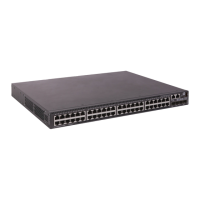94
Configuration file formats
Configuration files you specify for saving configuration must use the .cfg extension. A .cfg configuration
file is a human-readable text file. When you save configuration to a .cfg file, the device automatically
saves the configuration to an .mdb user-inaccessible binary file that has the same name as the .cfg file.
The device loads an .mdb file faster than loading a .cfg file.
Startup configuration file selection
At startup, the device uses the following procedure to identify the configuration file to load:
1. The device searches for a valid .cfg next-startup configuration file.
2. If one is found, the device searches for an .mdb file that has the same name and content as the .cfg
file.
3. If an .mdb file has the same name and content as the .cfg file, the device starts up with the .mdb
file. If none is found, the device starts up with the .cfg file.
Unless otherwise stated, the term "configuration file" in this document refers to a .cfg configuration file.
Configuration file content organization and format
IMPORTANT:
To run on the device, a configuration file must meet the content and format requirements. To ensure a
successful configuration load at startup, use a configuration file that was automatically created on the
device or created by using the save command. If you edit the configuration file, make sure all edits are
compliant with the requirements.
A configuration file must meet the following requirements:
• All commands are saved in their complete form.
• Commands are sorted in sections by command view, typically in this order: system view, interface
view, protocol views, and user interface view.
• Two adjacent sections are separated by a comment line that starts with a pound sign (#).
• The configuration file ends with the word return.
The following is a sample configuration file excerpt:
#
local-user root class manage
password hash
$h$6$Twd73mLrN8O2vvD5$Cz1vgdpR4KoTiRQNE9pg33gU14Br2p1VguczLSVyJLO2huV5Syx/LfDIf8ROLtV
ErJ/C31oq2rFtmNuyZf4STw==
service-type ssh telnet terminal
authorization-attribute user-role network-admin
authorization-attribute user-role network-operator
#
interface GigabitEthernet1/0/1
port link-mode route
ip address 1.1.1.1 255.255.255.0
#

